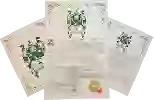
Winery DelorNature Bordeaux
In the mouth this red wine is a powerful with a nice balance between acidity and tannins.
This wine generally goes well with poultry, beef or veal.
Taste structure of the Nature Bordeaux from the Winery Delor
Light | Bold | |
Smooth | Tannic | |
Dry | Sweet | |
Soft | Acidic |
In the mouth the Nature Bordeaux of Winery Delor in the region of Bordeaux is a powerful with a nice balance between acidity and tannins.
Food and wine pairings with Nature Bordeaux
Pairings that work perfectly with Nature Bordeaux
Original food and wine pairings with Nature Bordeaux
The Nature Bordeaux of Winery Delor matches generally quite well with dishes of beef, veal or game (deer, venison) such as recipes of lomo saltado, ardéchoise fly or gigolette of rabbit.
Details and technical informations about Winery Delor's Nature Bordeaux.
Discover the grape variety: Esther
Interspecific crossing between the white Villard (Seyve-Villard 12375) and the magarcsi csemege obtained in 1969 in Hungary by Sandor Szegedi. This hybrid, most often used as a table grape, has been little multiplied and is still of great interest to amateur gardeners. It can be found in Hungary, Germany, Austria, Switzerland, Slovenia, ... completely unknown in France.
Informations about the Winery Delor
The Winery Delor is one of of the world's great estates. It offers 41 wines for sale in the of Bordeaux to come and discover on site or to buy online.
The wine region of Bordeaux
Bordeaux, in southwestern France, is one of the most famous, prestigious and prolific wine regions in the world. The majority of Bordeaux wines (nearly 90% of the production Volume) are the Dry, medium and Full-bodied red Bordeaux blends for which it is famous. The finest (and most expensive) are the wines of the great châteaux of Haut-Médoc and the right bank appellations of Saint-Émilion and Pomerol. The former focuses (at the highest level) on Cabernet Sauvignon, the latter on Merlot.
The word of the wine: Classified growth
Place name or castle subject to a classification (Médoc classification of 1855, classified growths of Alsace...)














